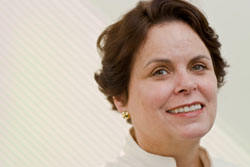New Faculty and Their Interests: Education in Many Forms
Regina Cortina
Associate Professor of Education
What do you teach?
I teach courses in comparative and international education. With other faculty members in my department, we are creating a Faculty Working Group on Latin American and Latino/a Education. Our goal is to unify and expand our research, teaching and service in this field in order to strengthen existing programs and pursue new initiatives. Growing out of my research, one course I have been teaching over the years, and will teach next semester, is "Education across the Americas," emphasizing the social dimensions of education, class, gender and race. Another course I teach is "Latinos in Urban Schools," which focuses on the critical educational issues facing Latinos in the United States.
What has been the focus of your research?
I have pursued an active agenda in interdisciplinary, comparative and international research throughout my career. In addition to my research on gender equity and education among girls and women in Latin America, my areas of expertise include the education and employment of teachers, comparative education in Latin America, public policy and education in Mexico, educational attainment among the poor in Latin America, and the schooling of Latin American-born students in the United States. My books include Distant Alliances: Promoting Education for Girls and Women in Latin America (2000); Lderes y construccin de poder: Las maestras y el SNTE (2003) [Leaders and the Construction of Power: Women Teachers and the National Teachers' Union in Mexico]; Immigrants and Schooling: Mexicans in New York (2003) based on my study of the Mexican migration to New York; and Women and Teaching: International Perspectives on the Feminization of a Profession (2006), concerning the causes and consequences of the feminization of teaching in Catholic countries in Europe, Latin America, the Caribbean, along with Britain and Canada.
What are your academic passions?
Since the late 1990s, a key focus of my work has been the impact of human migration on schools in the United States. As background for this emphasis, I should add that mass migration of Mexicans to the eastern seaboard started in the 1990s. This same phenomenon is bringing them from Florida to New York State. I have conducted research and made presentations on the migratory circuits that are bringing a larger and larger number of Latin American-born students to schools in theUnited States. My efforts aim to create a greater understanding of the needs of these students. Toward that end, I work actively with teachers and educational leaders to shape policies and practices that will expand educational opportunities for Latino students. Since the publication of my book on Mexican children in the public schools of New York, I have expanded my research along those lines to look more broadly at Latinos generally in New York City, offering an interpretation of patterns visible among the City's three largest Latino groups: Puerto Ricans, Dominicans and Mexicans. In all of my work, I am strongly committed to producing a new generation of graduate students, scholars and educational leaders who can help to create effective schools for the great diversity of students seeking opportunities to learn and grow in the United States today.
Published Friday, Dec. 14, 2007
